- Symptoms of a Bad Engine Coolant Temperature Sensor
- How a Temperature Sensor Works
- Coolant Temperature Sensor Location
- How Much Does it Cost for a Coolant Temperature Sensor?
- Common Engine Coolant Temperature Sensor OBDII Codes
- How To Test a Coolant Temperature Sensor
- Replacing a Coolant Temperature Sensor
Like all sensors on an engine, an engine coolant temperature sensor (CTS or ECT) is critical for a motor to run properly.
This is a guide for testing and replacing a temperature sensor if it is bad.
While every vehicle will have a different location for a sensor, the basic information below will be the same for almost any car or truck.
Symptoms of a Bad Engine Coolant Temperature Sensor
- Overheating
- Rough Idle
- Misfire
The most common problem of a bad ECT is the vehicle runs hot and overheats.
This is because the ECT controls when the fan turns on and off.
A bad ECT can also cause an engine to rough idle, misfire, or run poorly.
Other bad components can also cause the same symptoms so testing the sensor is the best way to see if it has failed.
How a Temperature Sensor Works
An ECT is a Thermistor that changes resistance depending on the temperature.
Higher temperatures will decrease the resistance as the temperature rises.
The voltage on the two wires of an ECT tells the computer when to regulate the temperature.
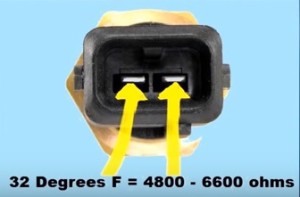
A 5-volt signal will go to the sensor on 1-wire, while the other wire sends a signal to the onboard computer (ECM/PCM).
The Thermistor resistance decreases as the engine warms up, which allows voltage to pass through.
Once voltage passes through the ECT, a connection is made between the two wires, which the computer is alerted to by the 5-volts DC.
After the computer receives the 5-volts, it starts to regulate the temperature, usually by turning on the fan.
Coolant Temperature Sensor Location
The most common location of the ECT is close to the thermostat, but this can vary.
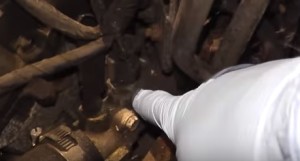
The best way to find the location is to search Google Images or buy a manual for your car or truck.
Vehicles usually have a single ECT sensor, but many newer cars and trucks can have multiple coolant sensors.
For example, some manufacturers have an ECT sensor on the engine and located on the radiator.
How Much Does it Cost for a Coolant Temperature Sensor?
Prices can vary depending on the vehicle, manufacturer, make, and model.
Most are less than $20-$30 dollars, but the only way to know is to look them up online.
Common Engine Coolant Temperature Sensor OBDII Codes
- P0115 – Engine Coolant Temperature Sensor 1 Circuit
- P0116 – Engine Coolant Temperature Sensor 1 Circuit Range/Performance
- P0117 – Engine Coolant Temperature Sensor 1 Circuit Low
- P0118 – Engine Coolant Temperature Sensor 1 Circuit High
- P0119 – Engine Coolant Temperature Sensor 1 Circuit Intermittent/Erratic
- P011A – Engine Coolant Temperature Sensor 1/2 Correlation
- P0125 – Insufficient Coolant Temperature for Closed Loop Fuel Control
- P0126 – Insufficient Coolant Temperature for Stable Operation
An OBD2 scanner tool can be used to scan for any codes a vehicle may have.
For example, a P0115 Code is often given for a bad ECT, but vehicles can throw any temperature code with a bad ECT.
Sometimes another code will show up also, such as a P0125 Code which means Insufficient Coolant Temperature and is related to the ECT.
Another common error is Code P0128 – Coolant Temperature Below Thermostat Regulating Temperature.
Keep in mind that temperature-related codes can be something else with the ECT only one part of the cooling system.
The ECT is one component that needs to be tested or replaced to see if it is a problem or if the problem is elsewhere.
How To Test a Coolant Temperature Sensor
First, be sure it is getting voltage at the harness; a bad harness or a cut in the wire can cause the same symptoms as a bad ECT.
To test the harness for voltage, turn the key to the ON position and use a multi meter to measure for 5 Volts DC.
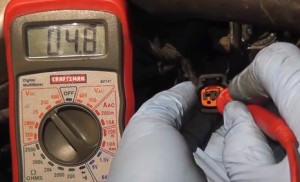
The voltage may vary slightly but should be close to 5 Volts.
If you get a good reading, the harness is good, and move on to testing the engine coolant sensor itself.
If you do not get a good 5-volt reading, the harness is bad, or a wire may have a cut somewhere.
(A continuity test can be done to test the wire that goes back to the computer.)
A sensor can be tested while still in the vehicle as long as it can be reached with the multi meter probes.
The first test should be done with the engine cold.
To test it with a meter, set it to Ohms to get a resistance reading.
Use the multi meter leads and touch the two prongs on the ECT where the harness plugs in.
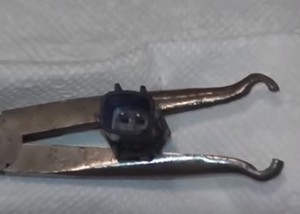
A good reading with a cold engine should be between 1.5 and 2 Ohms. If no reading is seen, then the sensor is bad.
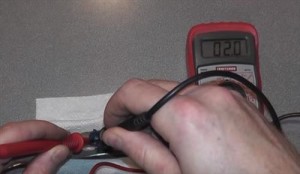
Sometimes a sensor can still give a reading but not be working correctly. To test this do the same reading but with the engine warmed up.
When the engine is warm, the resistance should drop. If it does not drop, then the sensor is bad and needs replacing.
Replacing a Coolant Temperature Sensor
Replacing an ECT is a straightforward process by using a wrench to unscrew it from its spot.
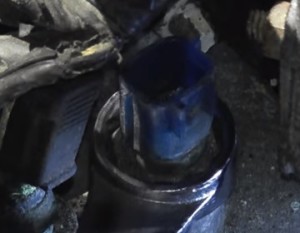
The harness will, of course, need to be removed, and the correct sized wrench will loosen it, allowing it to twist out.
It will depend on where the ECT is located as to how hard it is to remove. Hard to get to spots will make removing it difficult, while an easy access spot will make the job much simpler.
A new sensor will simply screw into the same spot. High-temperature sealant should be used on the threads of the new ECT to ensure a proper seal with no leaks.
Summary
Testing the ECT is an easy task that most any backyard mechanic can do.
Any cheap multi-meter can be used to test the unit and see if it has gone bad.
In the past, some DIY mechanics have jumpered the harness wire to send a 5-volt signal to the computer.
Jumpering the harness wires can work in some cases but be aware that it may damage the sensitive computer.
Also, jumpering the harness wires is not a permanent fix as it will not regulate the temperature properly.
Let us know your thoughts below in the comments.
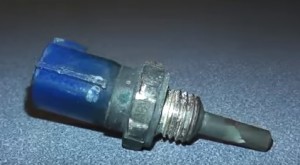
I would like to known if have a prob with my ect on 02npt cruiser tested it other morn while in the vehicle. Cold and weather was below 0. Could not test it on 20kohms so had to test it on 200kohms. Got reading of 45.6 ? Son warmed engine up to operating temp. Unhooked sensor. And thus time was able to test it on 20kohms got reading of. 0.90-1.00? To me doesn’t seem right ?
I got a p0128 code and was told by auto zone that its the coolant temp sensor after my check engine light came on. My temp gauge on dash was in the middle, my ac works fine, my cars not showing any of the signs for when the CTS or thermostat needs to be replaced. Now I’m really confused because the codes you listed are not the code I got.
There are different codes for an ECT always follow what the code is for your vehicle.
Nice article, but the resistance of the sensor should never read as low as 2 Ohms, that would be shorted. At room temperature (70 degrees) the GM ones will read about 3.4 K Ohms.
I have a 2000 Ford 6.8L v10, I have battery voltage at sensor plug. My dash gauges the oil pressure and temp gauge pegs once thermostat opens. If I unplug temp sensor oil pressure and voltage seems to read correctly. I did have the Speedo repaired and the guy said the gauges works on bench. Does the 5v you speak about come from instrument console or ECM? I getting ready to send console to an outfit that says they completely refurbish gauge console, but I don’t want to keep questioning on this. I did replace the temp sensor from autozone and the new one shows no ohm resistance when installed so that maybe a bad new . Anyone have suggestions?
I have a 2002 jeep Laredo V6 straight 4.0 Im getting a coolant low message on my over head control my cars temp runs perfect never over 210 its just an annoying chimes here an there when driving or ifshut car of an start it back up only thing is Idont have a voltage tool to test is can I unplug the sensor an still drive car as long as not over heating an not spitting shit out the coolant bottle. Reason asking if I can do it to see if its the sensor or the float inside bottle?…..
Another question is there suppose to be coolant fluid in the lil round part on the bottom of the float or is it suppose to be empty
Wife just took our jeep liberty thru a water puddle and noticed that the temp light came on.could this be caused by a sensor getting wet?
I have a fiat panda 4×4 and on a full tank fuel I dnt get full klms… Its jst taking fuel… Did a diagnostic and it said temperature switch is the fault.. Can this be the problem plz advice